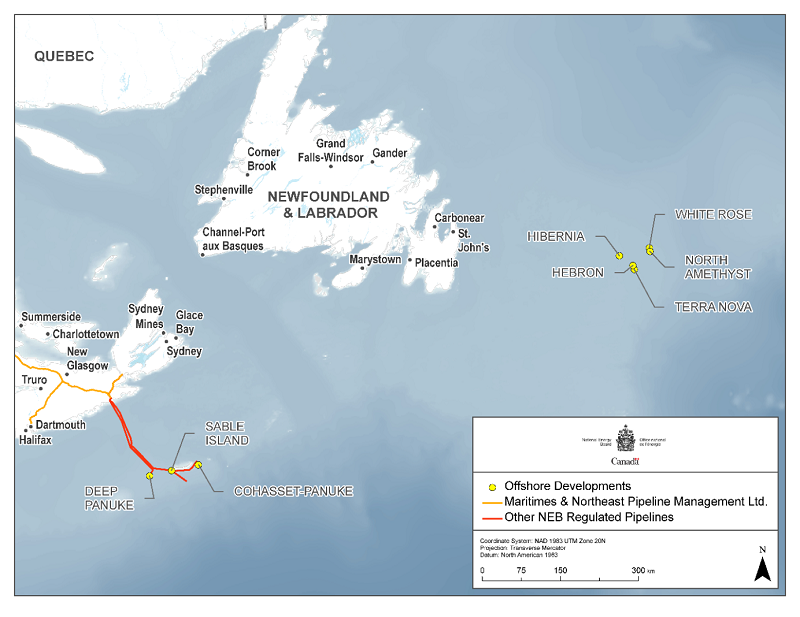Market Snapshot: 25 Years of Atlantic Canada Offshore Oil & Natural Gas Production
Release date: 2017-10-12
This year marks a quarter century of offshore oil and natural gas production in Atlantic Canada. From fields discovered as far back as 1969, production from Nova Scotia and Newfoundland and Labrador has allowed those provinces to fill growing global demand for oil and natural gas. While some fields are winding down, new discoveries are being made and new projects announced, leading to the expectation that Atlantic Canada will continue to be an active participant in Canada’s oil and gas sector for many years to come.
Map of Offshore Oil and Gas Activities in Atlantic Canada
Source and Description
Source: NEB
Description: This map illustrates the location of offshore developments in Atlantic Canada. Three developments are depicted off the shore of Nova Scotia: Deep Panuke, Sable Island, and Cohasset-Panuke. Five developments are depicted off the shore of Newfoundland, from east to west: Hibernia, Hebron, Terra Nova, White Rose, and North Amethyst. Overlaid is the Maritimes & Northeast Pipeline Management Ltd. in Nova Scotia. This connects to other NEB regulated pipelines, which connect to the three developments off shore of Nova Scotia.
Nova Scotia
Discovered in 1969 offshore of Nova Scotia, the Cohasset-Panuke project began production in 1992. It was Canada’s first offshore oil production project, and at its peak in 1993 produced just over 26 thousand barrels per day. Over the next six years, the project experienced natural production decline typical of conventional oil fields and was producing only 6 thousand barrels per day when it was commissioned in 1999.
Currently, two natural gas production projects are operating offshore Nova Scotia. The Sable Offshore Energy Project (SOEP), which began production in December 1999 and the Deep Panuke project which came online in 2013. Offshore Nova Scotia natural gas production peaked in December 2001 with SOEP production at just over 600 million cubic feet (17 million cubic metres) of gas per day. Deep Panuke production peaked in January 2014 at 287 million cubic feet (8.1 million cubic metres) per day. These fields have been in long-term natural decline since their respective peaks, averaging a combined 184 million cubic feet (5.2 million cubic metres) per day of production in 2016Footnote 1. Natural gas from these two projects is transported via the Maritimes & Northeast Pipeline. This gas is used to meet Maritimes’ demand and is also exported to the U.S. Northeast. Both Deep Panuke and SOEP projects have announced plans to decommission in the next several years.
Source and Description
Source: Canada-Nova Scotia Offshore Petroleum Board
Description: The chart illustrates average monthly raw natural gas production from Sable Island and Deep Panuke from December 1999 to June 2017. Production at Sable Island started in December 1999 and at Deep Panuke in August 2013. Record production occurred in the early 2000s, reaching annual levels of over 500 million cubic metres per day (MMcf/d). Production declined thereafter until mid-2013 when Deep Panuke was commissioned. Combined production averaged 347 MMcf/d in 2014 and has been declining. In 2016, production averaged 184 MMcf/d. Production averaged 165 MMcf/d in the first half of 2017.
Newfoundland and Labrador
Located over 300 miles offshore from St. John’s, the Hibernia oil platform began production in late 1997 marking the province’s first offshore production. Since that time, three additional fields began producing: Terra Nova, White Rose and North Amethyst, which were developed using floating production storage and offloading vessels and subsea tie backs.
In 1998, the first full year of production, offshore Newfoundland and Labrador averaged 65 thousand barrels (10 thousand cubic metres) per day. The province’s output continued to grow as new projects were added, peaking in 2007 at 368 thousand barrels (59 thousand cubic metres) per day. Production has been slowly decreasing over the past ten years, as operating fields progress through natural declines, and in 2016 averaged 210 thousand barrels (33 thousand cubic metres) per day. Oil production in Newfoundland and Labrador currently accounts for just over 6% of total Canadian oil productionFootnote 2. The majority of Newfoundland and Labrador’s production is exported to the U.S. and other international markets.Footnote 3
Source and Description
Source: Canada Newfoundland & Labrador Offshore Petroleum Board, NEB
Description: This graph shows Newfoundland and Labrador’s oil production and exports from 1998 to 2017. The bars show offshore production from four oil fields: Hibernia, Terra Nova, White Rose and North Amethyst. In 1998, oil production in the province was 65 thousand barrels per day. This increased to 286 thousand barrels per day in 2002, 305 thousand barrels per day in 2005, and 276 thousand barrels per day in 2010. Production in 2016 was 210 thousand barrels per day. In the first half of 2017, production averaged 230 thousand barrels per day. Hibernia was the only producing offshore oil field from 1998 until Terra Nova started producing in 2002. The White Rose oil field started production in 2005 and the North Amethyst oil field started production in 2010.
Production continues to expand as two new offshore projects are planned for Newfoundland and Labrador. The Hebron project was discovered in the 1990s and was approved by the Canada-Newfoundland and Labrador Offshore Petroleum Board in 2012. Plans to move forward with the project were announced in 2013 by ExxonMobil and it is scheduled to begin production in late 2017. Hebron is expected to produce over 700 million barrels over a 25-year period.Footnote 4 After operations commence, Hebron could produce up to 150 thousand barrels per day, slightly more than Hibernia’s production in 2016. In addition, the West White Rose project was approved in May 2017 and is expected to begin producing oil in 2022. It is estimated to have peak production of about 75 thousand barrels per day.
- Date modified:

